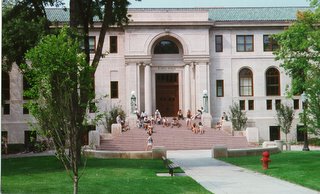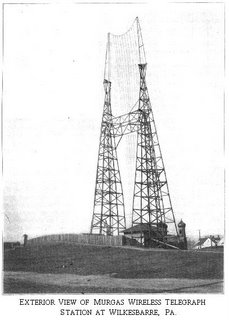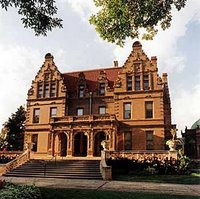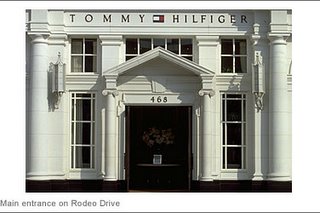
While my entire personal exposure to the city of Sacramento is restricted to a quick glance out the side-window of my family's car back during the nebulous days of childhood vacations, I am nonetheless most impressed by the incredible $34 million renovation completed recently in November of 2005 at the cathedral downtown. The restorers left Sacramento Cathedral far better than they found it, a true sign of hope for the future of ecclesiastical architecture.
Dedicated in 1889, the Cathedral of the Blessed Sacrament is a fascinating monument to the flamboyant eclecticism of Gilded Age America, here applied to a more worthy cause than the townhouses of railroad tycoons or the summer estates of the idle rich. I'm unsure what happened between then and now, but more recent photographs of the pre-restoration church show an interior of faded glory, with jaundiced salmon-pink walls, an unruly hodgepodge of architectural styles passing beyond even the church's deliberate eclecticism, and an unremarkable '60s-style altar island.
With the assistance of painters from EverGreene Studios in New York, Beyer Blinder Belle Architects and Harbison, Mahoney and Higgins Construction liberally coated the interior with 250 splendid new works of art in perfect harmony with the building's classical roots. The amount of original traditional artwork created for the project is, to my knowledge, unrivalled by any other ecclesial projects currently under construction, and includes everything from beautiful stencil-work to full-size canvases of apostles, saints and martyrs. Most ambitiously, the church restoration also included the replacement of the low false dome, dating from the 1930s, with a larger interior shell with a twenty-four foot oculus and an elaborate iconographic program.
The altar was replaced with a large marble structure containing relics of one of the martyrs of the Mexican
Cristero rebellion. The sanctuary of the church and the accompanying Eucharistic chapel is worth noting, as it is of somewhat novel--though not necessarily unsuccessful--design. The altar stands beneath the crossing in the untraditional "thrust sanctuary" form sometimes favored by certain modern liturgists. However, the large hanging crown or tester canopy with thirteen-foot-high crucifix standing over the crossing serves to give the freestanding altar the prominance it properly deserves. More intriguing is the placement of a screened Eucharistic chapel in the apse beyond the altar. The open arches allow some measure of privacy while allowing the six-ton, twenty-foot-high tabernacle canopy to serve as a visual focus for those seated in the main body of the church, and also to relate to the altar and sanctuary with a certain degree of appropriate hierarchy.
While not an appropriate arrangement for a parish church--despite some contemporary authors' suggestions to the contrary--a separate Eucharistic chapel may be considered more suitable for cathedrals. This is based on a number of rubrics from the old Tridentine rite that suppose this arrangement, or at least require that the Sacrament be reserved away from the high altar during pontifical fuctions. One must note, however, that the great St. Charles Borromeo placed his tabernacle above the high altar at Milan Cathedral, so these regulations are hardly universal.
In America, where most cathedrals were essentially designed to serve as oversized parish churches, without the accompanying ceremonial of the cathedral chapters of canons so common in Europe, this custom never caught on, and due to the current controversies over tabernacle placement in parish church, prudence suggests that the implementation of this fairly well-established tradition might be reserved for a more felicitous time when it might not further endanger the belief in the Real Presence.
This rather novel arrangement, however, permits some of the separation considered important by some older authorities in a cathedral church without denying the view of the home of the Sacrament to the larger body of the faithful. Only two problems present themselves--one, the odd antiphonal seating in the chapel, which might make Eucharistic adoration difficult, and two, the potential distraction of laity moving about behind the altar in a space on the same level as it, and, to some degree, serving as an extension of the sanctuary. (It would make a fine space for a chapter of canons to sit, though!)
I am unsure whether I would recommend the adoption of this practice in other cathedrals, though I am glad the experiment was tried, as it is at least a gesture towards tradition. It is more preferrable, I believe, to the arrangement at the otherwise quite unobtrusive renovation at Salt Lake City which places the tabernacle on axis with the altar but obscures it with a virtually opaque screen.
However, certainly we must extend our congratulations to the diocese for this wondrous re-fitting of an old, if somewhat tarnished, gem. May it be a light to other dioceses and their faithful at the beginning of this century, in the hopes of helping to further another renaissance of ecclesial design.
For more information and photographs of the project, see the PDF slideshow, and the Cathedral website.
















